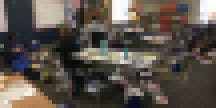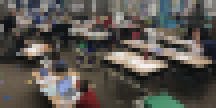Have you ever been in a classroom when a principal walks in? Planned or random, evaluative or not, the atmosphere changes.
The entrance of an administrator can create tension where there was none, or it can relieve stress—but that depends on the relationship between the administrator and teacher as well as the culture and purpose of observations in a school. In the best case, the teacher knows that the observer is there to support and welcomes the observation, but in my experience that scenario is the exception, not the rule.
An increasing number of schools are abandoning traditional models of teaching and learning to better support the modern learner. Educators are often expected to take bold steps in support of these transitions and to make major changes to their practices that can put them outside their comfort zone. New tools and teaching methods have emerged and the tried and true lessons that have been used for decades are no longer best practice. But as teachers change their practices to meet their students’ needs, how are administrators changing the way they observe and provide feedback to teachers?
During my 10 years as a classroom music teacher, I worked with 10 different administrative teams and experienced a wide range of evaluative classroom observations. I am now on the other side of the equation as a district-level technology leader, and I want to apply the lessons I’ve learned from my experience as the "observed" to my practice as a supporter and observer in a constantly evolving learning environment.
In 2017, our district began revising its 5-year strategic plan. One of our priorities was transitioning to personalized learning environments. We identified digital tools as one element of the shift, but recognized that was only one piece of the puzzle and that implementation would look different across classrooms. By Fall 2017, we had moved towards a model that valued collaboration and conversation amongst students, flexible furniture in learning spaces and the use of digital devices. To some administrators this shift didn’t look like a engaging learning environment—it looked like chaos.

Students are often spread out around the room, loudly conversing with each other while the teacher works with a small group of learners off to the side. Devices and phones are strewn across the classroom. Learning objectives, topics and assignments are no longer written on the board. Instead, an observer might see scribbled notes from students with questions and drawings. Many teachers wouldn’t want an administrator to walk into this “mess,” much less base their evaluation on it, but our teachers do. The perceived chaos described is intentional. Our teachers are exploring new ways to engage learners and they want help refining their craft.
Since launching our digital learning initiative three years ago, we have realized that the traditional style of evaluative observations we’ve used for decades doesn't work for our teachers anymore. Administrators can no longer get an accurate overview of a teacher’s effectiveness from sitting in the back of the classroom filling out a rubric. We knew that if we wanted to align our district’s strategic goals with current tools and best practices, we needed to see our classrooms in action.
As a first step, our leadership team designed a day of “digital learning rounds" to give our district administrators an opportunity to practice non-evaluative observations of student-directed, digitally enhanced learning environments. I was part of the team that designed and led the rounds, so I got to visit classrooms with two groups of amazing leaders, listen to their observations and feedback about the changing roles of teachers and administrators, and report back to our three-person leadership team to inform next steps.
The participants were grouped according to position and grade level and each group was scheduled to spend time in three classrooms for 12 minutes each. We prepared by setting expectations, discussing what to look for and reviewing logistics. The preparations focused on looking for evidence of three frameworks we have prioritized across the district and that our teachers have been working on implementing—the 5 C’s (communication, creativity, collaboration, critical thinking and citizenship) of college and career readiness, the different stages of SAMR (substitution, augmentation, modification and redefinition) and the TPACK model (technological pedagogical content knowledge).
The teachers we visited invited us into their learning environment without hesitation. They had been notified in advance and were expecting us. Observers took some notes, but mostly engaged in active listening as students energetically shared about their learning with any available visitor they could find. We noticed students using a lot of digital tools, but it was really the ownership of their learning and the engagement we witnessed inside of these classrooms that made the biggest impact.

The district leaders gathered after their visits to process, reflect and share what they had learned. Every administrator commented on at least one practice they had never seen in a classroom before. When we removed the evaluative nature of the observation and got rid of the checklist of outdated practices to look for, our administrators were able enter each room with an open mind and could see how the changes in the learning environment were benefiting students. It became apparent that a major transformation had taken place.
Yes, students were spread out all over the classroom, but they were comfortable in their revamped workspaces and they were focused as they discussed complex issues like soil erosion, endangered species and roof construction. Students were leading themselves through units of study, engaging in discovering new ideas, and reporting back to teachers with excitement about the projects they were working on.
Observers realized that the whiteboard at the front of the room was no longer a teacher tool, but a workspace where students could process and share, and it became clear that the teachers hadn’t stopped providing guidance for students, they had given instructions digitally and verbally at the beginning of class and let their students move forward independently. The learners weren’t lost or confused, they were self-directed, and as their teachers stealthily moved from group to group, monitoring progress, giving suggestions they beamed with pride at the growth of their students.
As we debriefed that day, the “aha” moment we shared was that as our expectations of teachers change, we need to rethink how administrators support them. If we keep looking at the same indicators, we risk enforcing stagnation as opposed to encouraging growth.
We’re still learning how to best support the growth of our teachers. We know we need to build a positive culture around observation, and that the most impactful feedback stems from strong relationships between teachers and administrators.
In our district, we’re committing to going into classrooms more often, carving out time for teachers to observe each other and making our observations less about checklists and more about listening to students and teachers. Most of all, we are committing to shifting our mindset so that we don’t jump to any conclusions—if at first something seems like chaos, it might actually turn out to be learning.


